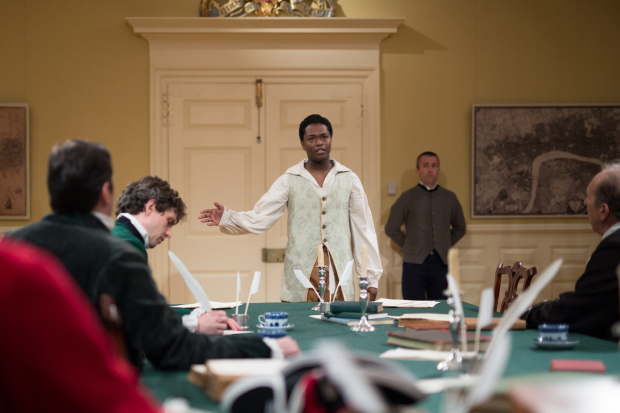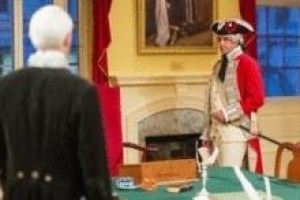Blood on the Snow
The aftermath of an event that changed the course of our history is staged where it happened.

(© Justin Saglio)
Few American cities can do site-specific reenactments as well as Boston, especially when it comes to events from the country's past. Playwright Patrick Gabridge has brought the Boston Massacre to life in his drama Blood on the Snow, which has been staged at the Old State House overlooking the site of the violence. The play sold out every performance a year ago at its premiere and has been remounted by the Bostonian Society in the same Council Room where the Crown's officials met the next day to try to appease the colonists.
In July 1768, two regiments of British soldiers arrived in Boston to help keep the peace in a population that was increasingly angry about their treatment by the king and parliament. As many as 2,000 soldiers were eventually posted in the town of 15,000 subjects, leading to confrontations between the troops and the citizens. On the night of March 5, 1770, a group of young boys threw snowballs at the sentry on guard at the Custom House. The ringing of bells called out more people who further taunted the guard. Fearing for his life, the redcoat called for reinforcements.
A party of seven Grenadiers arrived, forming a defensive circle at the foot of the Custom House stairs. When one soldier was hit by a stick, he fell, firing his musket. More soldiers fired, and five colonists were killed, including the former slave, Crispus Attucks. Six more were wounded. The acting royal governor, Thomas Hutchinson, an American-born representative of the Crown, rushed to the scene and urged everyone to go home. The following morning, the local government, the Town Meeting at Faneuil Hall, issued a resolution: "Nothing less will satisfy, than a total and immediate removal of all the Troops."
Gabridge's play reflects the central issue of the conflict, as stated by Governor Hutchinson (Dale Place): He insisted that he did not have the legal authority to remove the troops, which lay with General Gage in New York. In addition to Hutchinson, the all-male cast includes Andrew Oliver, the Provincial Secretary and Hutchinson's brother-in-law (Ken Baltin), Lt. Colonel William Dalrymple, commander of the British troops (Daniel Berger-Jones), members of the Governor's Council: Royall Tyler (Bill Mootos), Harrison Gray (Jerry Goodwin), and Samuel Dexter (Lewis Wheeler). Samuel Adams (Craig Ciampa) and John Hancock (Matt Ryan) arrive with the ultimatum from Town Meeting. When the slave, Andrew (Trinidad Ramkissoon), an eyewitness to the massacre, comes in to deliver his account to the Council, the reluctance of the members to listen to him is a stark reminder that slavery knew no borders in colonial America. The frightened doorkeeper, William Baker (Scot Colford), keeps order at the entrance as best he can and serves the tea.
Under the perceptive direction of Courtney O'Connor, and the superb acting of the ensemble, the tension starts high and only rises from there. The period costumes, designed by Laurie Bramhall, and roiling street sounds devised by Brendan F. Doyle, add to the sense of reality for the viewers, who are seated against the two long walls of the Council Chamber while the actors pace around the long table in the center. A replica of the red-and-blue emblem of the monarchy is mounted over the doorway, opposite portraits of Charles I and James II which flank the windows.
The Old State House is an important stop on Boston’s famed "Freedom Trail." Adding this production to the must-see landmarks of the city’s colonial history helps bring the period to life, to remind us that the roots of the American Revolution are planted firmly beneath the cobblestone streets. The actors of Blood in the Snow are a reminder that the names in our history books were once real men willing to take action, despite the risks.
Even though Acting Governor Hutchinson and his advisers finally ordered the troops to leave, within five years the American Revolution would begin. The United States was founded from this conflict, forming a democracy that would be tested by trauma time and time again. The stories about our nation’s survival must be remembered and continually retold, to give us courage now and hope for the future.









